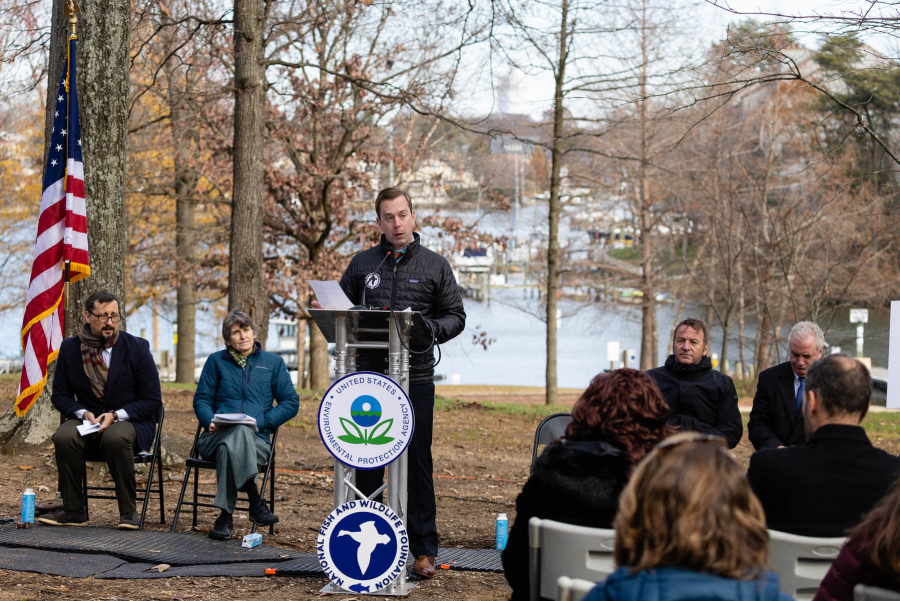Record amount of funding awarded to spur watershed restoration
Chesapeake Bay Stewardship Fund finances 104 projects throughout the region

On a chilly, early December morning in Annapolis, Maryland, several Chesapeake Bay Program partners gathered on the banks of Spa Creek, a tributary of the Chesapeake Bay in Truxtun Park, to announce that a record-breaking $33.8 million was being awarded across the watershed to further restoration projects.
Janet McCabe, the deputy administrator for the U.S. Environmental Protection Agency (EPA) remarked that, “this funding not only helps kickstart critical water quality programs within the Chesapeake Bay watershed, it represents an investment in public health and the communities who call the Bay home.”
The National Fish and Wildlife Federation (NFWF) has administered the Chesapeake Bay Stewardship Fund since 2006—awarding over $232 million in two different grant programs to 496 projects across the watershed. The Innovative Nutrient and Sediment Reduction (INSR) Grants support groundbreaking solutions to reduce or eliminate nitrogen, phosphorus and sediment pollution entering the Chesapeake Bay. The Small Watershed Grants (SWG) are awarded to local governments and non-governmental organizations that work to protect and improve local waters and habitats across the watershed while building community stewardship.
The Bipartisan Infrastructure Law, passed in November 2021, provided even more money to organizations throughout the region this year—ensuring 104 projects to restore the Bay and its watershed would be funded. Appropriations for the Chesapeake Stewardship Fund comes from the EPA, U.S. Department of Agriculture’s Natural Resources Conservation Service, U.S. Forest Service and the Department of Interior’s U.S. Fish and Wildlife Service, in addition to private funding.
Included in the newly funded projects is $500,000 to the City of Annapolis for installing a living shorelines that will improve water quality, habitat and resilience in Hawkins Cove, as well as increase access to the water. Additional projects from across the watershed include:
- Delaware Wild Lands will receive $177,600 to restore a prior agricultural field back to a native coastal plain upland forest and native meadow habitat in the Great Cypress Swamp. The project will ultimately restore 25 acres of habitat and nearly a half mile of riparian habitat.
- In the District of Columbia, the Rock Creek Conservancy will receive $74,900 to create a plan to restore and maintain the forests in the Rock Creek watershed. The project will also engage community members in sustaining this restoration beyond the borders of Rock Creek Park.
- The Tioga County Soil and Water Conservation District will accelerate tree plantings in riparian and upland areas of the Upper Susquehanna watershed in New York with the $500,000 they received. Overall, the project will result in 30,000 new trees planted across more than 100 acres.
- The Alliance for the Chesapeake Bay will use $75,000 to complete six preliminary concept plans for agricultural conservation practices for producer members of the Dairy Farmers of America cooperative to improve drinking water in south-central Pennsylvania.
- In Virginia, the Elizabeth River Project will use $1,000,000 to explore creative approaches to motivate the sustainable engagement of environmentally and economically vulnerable communities in equitable restoration of urban tributaries of the Chesapeake Bay. They expect to implement 10 on-the-ground projects, including living shorelines, rain gardens, conservation landscaping and tree plantings in targeted communities to reduce pollution while improving the capacity of social programs to reach under-resourced communities.
- The West Virginia National Guard Foundation will receive $499,100 to improve the transport of poultry litter to enhance abandoned mine reclamation efforts across the state. The project will support mine reclamation efforts on 180 acres for the Patriot Apple Project, which benefits ex-coal miners and veterans throughout the region.
“Our partners and collaborative approaches bring farmers, homeowners, communities, businesses and local leaders together as a team, working in partnership to reduce pollution, improve water quality and revitalize their communities,” said McCabe.
For the full list of awardees, please visit the INSR and SWG websites.

Comments
There are no comments.
Thank you!
Your comment has been received. Before it can be published, the comment will be reviewed by our team to ensure it adheres with our rules of engagement.
Back to recent stories